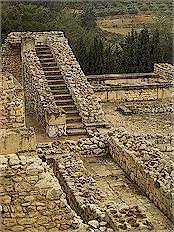



New York City
On last Monday, I finally saw the frescos and fine art of the Minoan civilization that existed in Crete ( and other colonies) 5000 years ago.
This incredible civilization wasn't discovered until the late 1800s, and wasn't excavated until 1902 or so. Remember, Crete was still under Turkish rule up until that time, and digs weren't possible. Arthur Evans, a Brit, came in after Crete became independent, and began one of the most exciting digs of the past 300 years.
He unearthed at Knossos, an area close to the major modern port Iraklion, the astonishing remains of at least five periods of life --from Neolithic to Roman. But the most interesting was the Minoan culture which settled there in about 3000 B.C.E. The Minoans, named after their king, Minos, were extremely sophisticated--note the staircase in the pictures above--that led to the king and queen's suites. It seems the king had established trade with the Egyptians for sure based on some of the treasures found in Knossos that bear the seal of an Egyptian king. They were also masterful with the arts. Findings included gold necklaces, precious stone bracelets, to name a few. They also understood how to make faience, a type of pottery that is still considered lovely today.
The Minoans worshipped the Earth Goddess and many images like the Earth Goddess ( called Snake Goddess in the picture above ) were found on the site. These ancient people saw that the woman could bear life, and nurture life ( note her uncovered breasts ) and therefore, the major force in the universe must be female. The snake was a symbol of her power over the underworld, and her hands were outstretched toward the heavens that she also ruled. Knossos was built on a river valley--and they believed the Goddess kept the land fertile for the many inhabitants--probably as many as 200,000 during the culture's peak years.
In each Minoan city that has been found, there was a large flat area about the size of a basketball court that was used for bull leaping. Frescoes from the site show young men ( like the one above ) leaping over a bull as a game of skill --or perhaps a ritual, coming of age. Can you imagine?
I've seen lots of ruins in the past three weeks. But this ancient site was the most interesting because of it's diversity of cultures that occupied the land. Each culture, first the earliest men on earth, then the Minoans, then the Romans, built their palaces and roads on top of one another. It produced an incredible "legend" of 7000 years of human existence. Overwhelming, really.
A note: the Germans occupied Crete during WW II. Why? Because it was so strategically located in the Mediterranean. ( They weren't the first: Crete was conquered or bought depending on who you talk to by the Venetians, then the Turks took over, then independence and consolidation with the rest of Greece until the Germans invaded.) But this is the good news. The Germans did not touch the artifacts that, by that time, were housed in Iraklion in a museum. Not one thing did they take back to Germany or destroy. Consequently, Crete has all of these world class artifacts in their very fine archeological museum--worth the entire trip just to view.
So, my advice is go to Crete. Stay anywhere but Iraklion, and spend 3 days or so there--just to see these absolute gifts from the past. It's some of the finest examples of art I've ever seen anywhere.
More on Turkey, perhaps an overview of the major highlights, tomorrow. Then on to the present day and life in the day to day.
M.C.
No comments:
Post a Comment